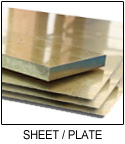C46400 Naval Brass
If you have spent any time around metals then you know just how malleable and strong brass is. This is primarily due to its combination of copper and zinc - and the occasional addition of tin and other metals. And while brass is good for a lot of things, it is not good for conditions that require constant contact with varying humidity, moisture, or water. Especially if it is saltwater. For this type of application, you are going to need Naval Brass, a type of brass classified as Alpha.
C46400 is the classic Naval Brass and gets its name from its historical application in the marine trades. Sometimes referred to as Marine Brass, this metal has been widely used in military applications. Thanks to the addition of tin and zinc, it holds up well in wet conditions - including underwater environments.
Naval Brass has been used as propeller shafts, marine hardware, and fittings. It is a great metal choice to use in both salt water and freshwater applications. In addition, it has many industrial applications.
As mentioned, because of its strong, corrosive-resistant and hardness it is also a great material to use for industrial applications. It has been used for welding rods, condenser tubes, structures, aircraft parts, decorative and more.
Atlas carries C46400 Naval Brass in Sheet, Plate and Rounds and we also have it in a specialty product, C46400 Diamond Cut Naval Brass Plate. We carry a wide range of diameters in solid bar stock and thicknesses in the sheet and plate. We will cut the material to length. C46400 Naval Brass is one of the top choices for industrial and marine atmosphere applications. This is due to it's high corrosion resistance to seawater.


 
 
C46400 Naval Brass properties give it fair to excellent corrosion resistance. Excellent hot workability and hot forgeability. Fabricated by blanking, drawing, bending, heading and upsetting, hot forging, pressing.
C46400 NAVAL BRASS TYPICAL USES
Some of the typical areas that C46400 is used in, is as follows:
- Air Pressure Conveyor Systems
- Sound Proofing Equipment
- Springs
- Chain
- Bead Chain
- Tubing for Instruments
- Tubing for Machines
- Heat Exchangers
- Pump Cylinders
- Wire Screens
- Pumps
- Liners
- Power Cylinders
TYPICAL C46400 NAVAL BRASS CHEMICAL COMPOSITION
(%max., unless shown as range or min.)
NOTE: Information courtesy copper.org
|
Cu
|
Fe
|
Pb
|
Zn
|
|
Min./Max.
|
68.5-71.5
|
.05
|
.07
|
Rem.
|
|
Nominal
|
70.0
|
-
|
-
|
30.0
|
Note: Cu + Sum of Named Elements, 99.7% min.
TYPICAL C46400 NAVAL BRASS MECHANICAL PROPERTIES
(measured at room temperature, 68 F (20 C)
NOTE: Information courtesy copper.org
|
Temper
|
Section
Size
|
Cold
Work
|
Typ/
Min
|
Temp
|
Tensile
Strength
|
Yield
Strength
(0.5% ext.
under load)
|
Yield
Strength
(0.2%
offset)
|
Yield
Strength
(0.05%
offset)
|
El
|
Rockwell
Hardness
|
Vickens
Hard.
|
Brinell
Hard.
|
Shear
Strength
|
Fatigue
Strength*
|
Izod
Impact
Strength
|
|
in.
|
%
|
|
F
|
ksi
|
ksi
|
ksi
|
ksi
|
%
|
B
|
C
|
F
|
30T
|
500
|
500
|
3000
|
ksi
|
ksi
|
ft-lb
|
|
mm.
|
|
|
C
|
MPa
|
MPa
|
MPa
|
MPa
|
|
|
|
|
|
|
|
|
MPa
|
MPa
|
J
|
|
Tube
|
|
H80
|
0.0
|
35
|
TYP
|
68
|
78
|
64
|
-
|
-
|
8
|
82
|
-
|
-
|
73
|
-
|
-
|
-
|
-
|
-
|
0.0
|
|
0.0
|
|
|
20
|
538
|
441
|
-
|
-
|
8
|
82
|
-
|
-
|
73
|
-
|
-
|
-
|
-
|
-
|
0.0
|
|
Flat Products
|
|
OS015
|
0.04
|
0
|
TYP
|
68
|
53
|
22
|
-
|
-
|
54
|
-
|
-
|
78
|
43
|
-
|
-
|
-
|
35
|
14
|
0.0
|
|
1
|
|
|
20
|
365
|
152
|
-
|
-
|
54
|
-
|
-
|
78
|
43
|
-
|
-
|
-
|
241
|
97
|
0.0
|
|
H02
|
0.04
|
0
|
TYP
|
68
|
62
|
52
|
-
|
-
|
25
|
70
|
-
|
-
|
65
|
-
|
-
|
-
|
40
|
18
|
0.0
|
|
1
|
|
|
20
|
427
|
359
|
-
|
-
|
25
|
70
|
-
|
-
|
65
|
-
|
-
|
-
|
276
|
124
|
0.0
|
|
Flat Products
|
|
H06
|
0.04
|
0
|
TYP
|
68
|
86
|
65
|
-
|
-
|
5
|
88
|
-
|
-
|
76
|
-
|
-
|
-
|
46
|
-
|
0.0
|
|
1
|
|
|
20
|
593
|
448
|
-
|
-
|
5
|
88
|
-
|
-
|
76
|
-
|
-
|
-
|
317
|
-
|
0.0
|
|
OS100
|
0.04
|
0
|
TYP
|
68
|
44
|
11
|
-
|
-
|
66
|
-
|
-
|
54
|
11
|
-
|
-
|
-
|
-
|
13
|
0.0
|
|
1
|
|
|
20
|
303
|
76
|
-
|
-
|
66
|
-
|
-
|
54
|
11
|
-
|
-
|
-
|
-
|
90
|
0.0
|
|
OS035
|
0.04
|
0
|
TYP
|
68
|
49
|
17
|
-
|
-
|
57
|
-
|
-
|
68
|
31
|
-
|
-
|
-
|
34
|
14
|
0.0
|
|
1
|
|
|
20
|
338
|
117
|
-
|
-
|
57
|
-
|
-
|
68
|
31
|
-
|
-
|
-
|
234
|
97
|
0.0
|
|
H04
|
0.04
|
0
|
TYP
|
68
|
76
|
63
|
-
|
-
|
8
|
82
|
-
|
-
|
73
|
-
|
-
|
-
|
44
|
21
|
0.0
|
|
1
|
|
|
20
|
524
|
434
|
-
|
-
|
8
|
82
|
-
|
-
|
73
|
-
|
-
|
-
|
303
|
145
|
0.0
|
|
Flat Products
|
|
H08
|
0.04
|
0
|
TYP
|
68
|
94
|
65
|
-
|
-
|
3
|
91
|
-
|
-
|
77
|
-
|
-
|
-
|
48
|
23
|
0.0
|
|
1
|
|
|
20
|
648
|
448
|
-
|
-
|
3
|
91
|
-
|
-
|
77
|
-
|
|
|








